E-medical Project Management: System Implementation and Analysis
VerifiedAdded on 2019/10/09
|24
|4525
|304
Project
AI Summary
This project management assignment details the development of an e-medical system, designed to improve healthcare access and efficiency. The project, undertaken by a non-governmental organization, outlines the system's overview, key features, recommended administrative system, and implementation strategies. It includes a comprehensive analysis of goals, objectives, vendors, costs, and perceived benefits. The assignment further covers implementation tasks, resource needs, staff training, legislative requirements, and system evaluation and monitoring procedures. The system focuses on providing health information, online services, and improved patient-physician communication. It emphasizes data security, easy payment methods, and personalized care, particularly for vulnerable populations. The project incorporates modules for database management, patient and physician interaction, medicine and equipment, security, and distribution, all running on ASP.NET and SQL Server. The project aims to improve health and wellness by providing valuable information and resources, ultimately leading to better healthcare outcomes. The project also includes internal consultation and communication plans, detailing stakeholder requirements and responsibilities. The project is designed to be completed within four months.
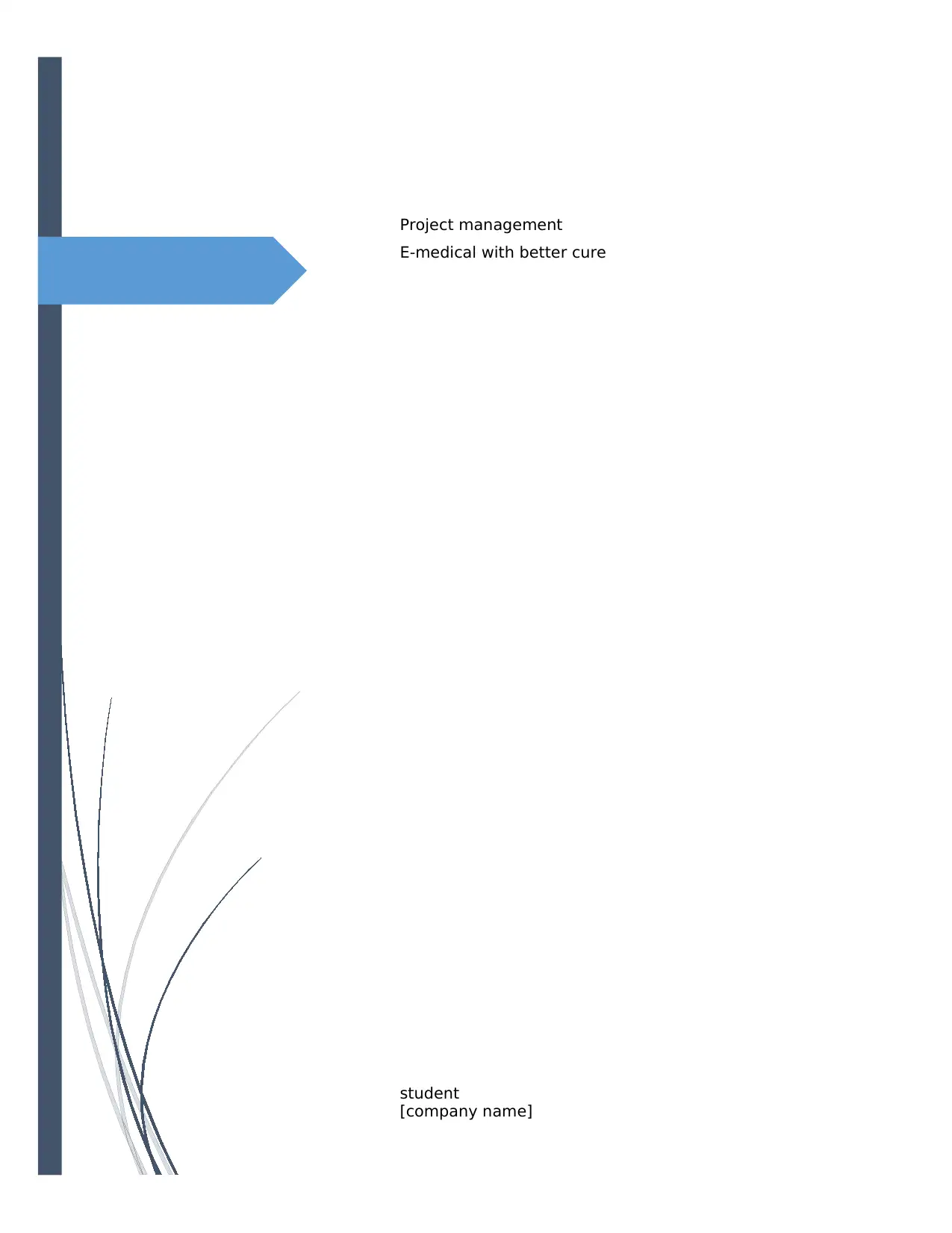
Project management
E-medical with better cure
student
[company name]
E-medical with better cure
student
[company name]
Paraphrase This Document
Need a fresh take? Get an instant paraphrase of this document with our AI Paraphraser

1
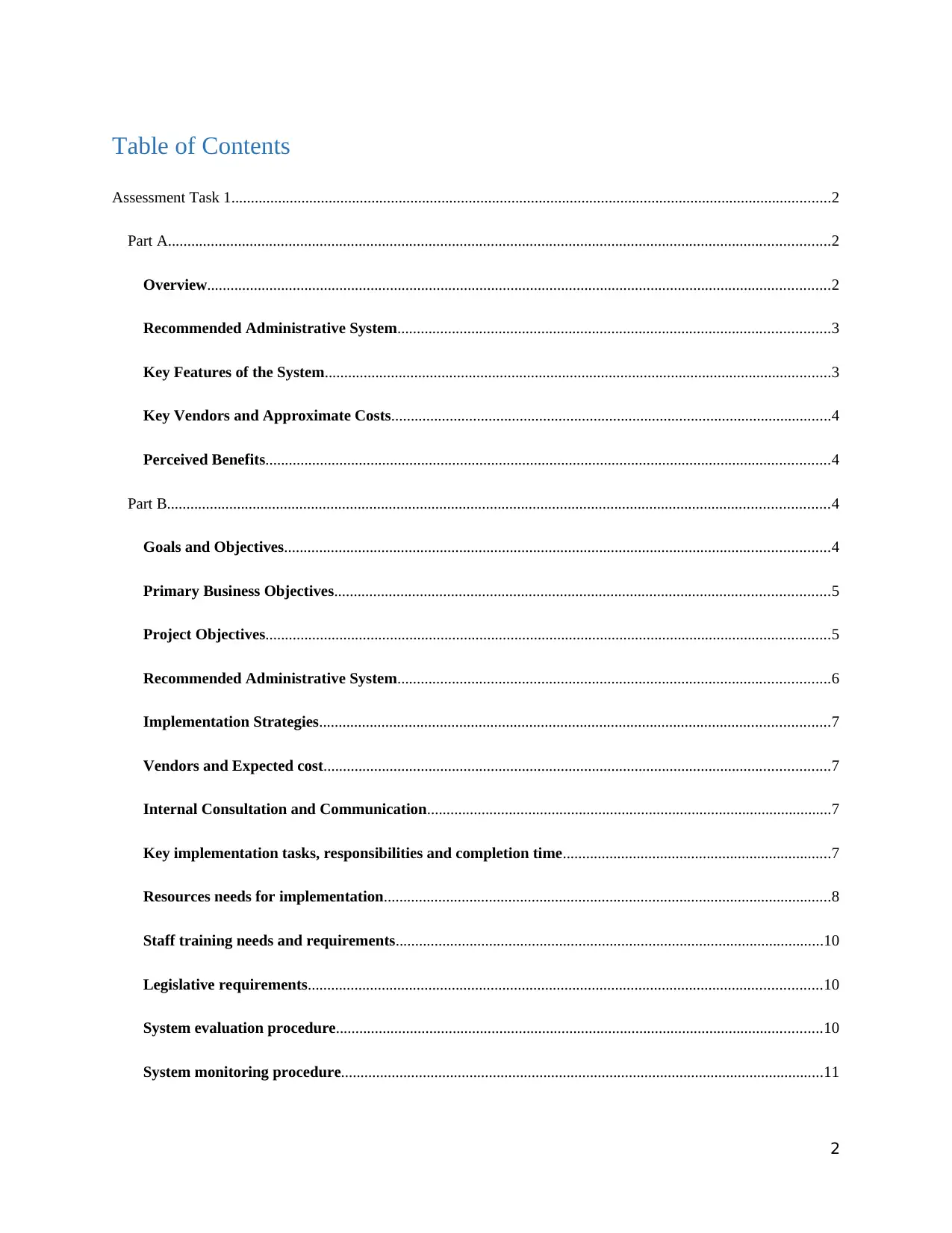
Table of Contents
Assessment Task 1..........................................................................................................................................................2
Part A..........................................................................................................................................................................2
Overview................................................................................................................................................................2
Recommended Administrative System...............................................................................................................3
Key Features of the System..................................................................................................................................3
Key Vendors and Approximate Costs.................................................................................................................4
Perceived Benefits.................................................................................................................................................4
Part B..........................................................................................................................................................................4
Goals and Objectives............................................................................................................................................4
Primary Business Objectives...............................................................................................................................5
Project Objectives.................................................................................................................................................5
Recommended Administrative System...............................................................................................................6
Implementation Strategies...................................................................................................................................7
Vendors and Expected cost..................................................................................................................................7
Internal Consultation and Communication........................................................................................................7
Key implementation tasks, responsibilities and completion time.....................................................................7
Resources needs for implementation...................................................................................................................8
Staff training needs and requirements..............................................................................................................10
Legislative requirements....................................................................................................................................10
System evaluation procedure.............................................................................................................................10
System monitoring procedure............................................................................................................................11
2
Assessment Task 1..........................................................................................................................................................2
Part A..........................................................................................................................................................................2
Overview................................................................................................................................................................2
Recommended Administrative System...............................................................................................................3
Key Features of the System..................................................................................................................................3
Key Vendors and Approximate Costs.................................................................................................................4
Perceived Benefits.................................................................................................................................................4
Part B..........................................................................................................................................................................4
Goals and Objectives............................................................................................................................................4
Primary Business Objectives...............................................................................................................................5
Project Objectives.................................................................................................................................................5
Recommended Administrative System...............................................................................................................6
Implementation Strategies...................................................................................................................................7
Vendors and Expected cost..................................................................................................................................7
Internal Consultation and Communication........................................................................................................7
Key implementation tasks, responsibilities and completion time.....................................................................7
Resources needs for implementation...................................................................................................................8
Staff training needs and requirements..............................................................................................................10
Legislative requirements....................................................................................................................................10
System evaluation procedure.............................................................................................................................10
System monitoring procedure............................................................................................................................11
2
⊘ This is a preview!⊘
Do you want full access?
Subscribe today to unlock all pages.

Trusted by 1+ million students worldwide
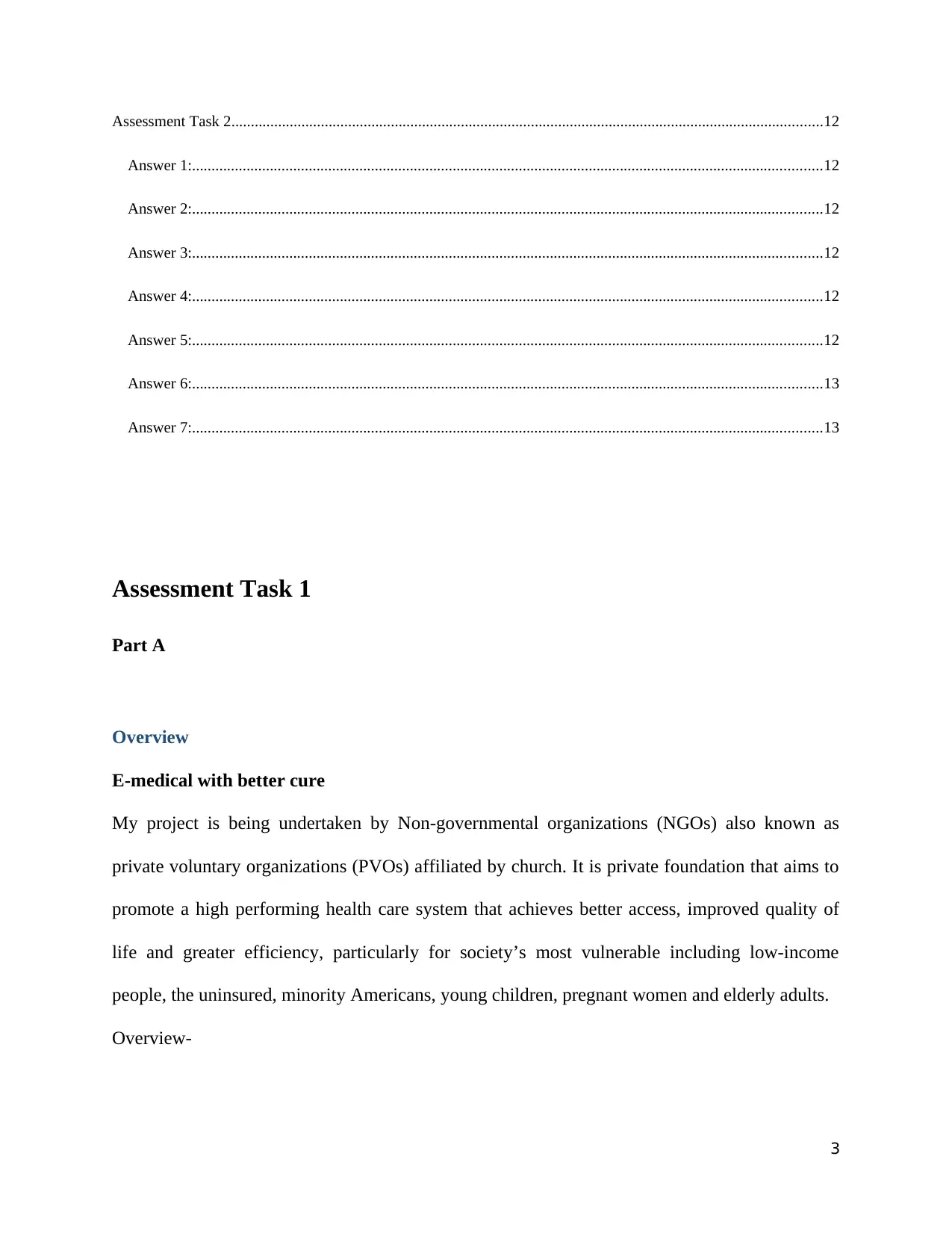
Assessment Task 2........................................................................................................................................................12
Answer 1:..................................................................................................................................................................12
Answer 2:..................................................................................................................................................................12
Answer 3:..................................................................................................................................................................12
Answer 4:..................................................................................................................................................................12
Answer 5:..................................................................................................................................................................12
Answer 6:..................................................................................................................................................................13
Answer 7:..................................................................................................................................................................13
Assessment Task 1
Part A
Overview
E-medical with better cure
My project is being undertaken by Non-governmental organizations (NGOs) also known as
private voluntary organizations (PVOs) affiliated by church. It is private foundation that aims to
promote a high performing health care system that achieves better access, improved quality of
life and greater efficiency, particularly for society’s most vulnerable including low-income
people, the uninsured, minority Americans, young children, pregnant women and elderly adults.
Overview-
3
Answer 1:..................................................................................................................................................................12
Answer 2:..................................................................................................................................................................12
Answer 3:..................................................................................................................................................................12
Answer 4:..................................................................................................................................................................12
Answer 5:..................................................................................................................................................................12
Answer 6:..................................................................................................................................................................13
Answer 7:..................................................................................................................................................................13
Assessment Task 1
Part A
Overview
E-medical with better cure
My project is being undertaken by Non-governmental organizations (NGOs) also known as
private voluntary organizations (PVOs) affiliated by church. It is private foundation that aims to
promote a high performing health care system that achieves better access, improved quality of
life and greater efficiency, particularly for society’s most vulnerable including low-income
people, the uninsured, minority Americans, young children, pregnant women and elderly adults.
Overview-
3
Paraphrase This Document
Need a fresh take? Get an instant paraphrase of this document with our AI Paraphraser
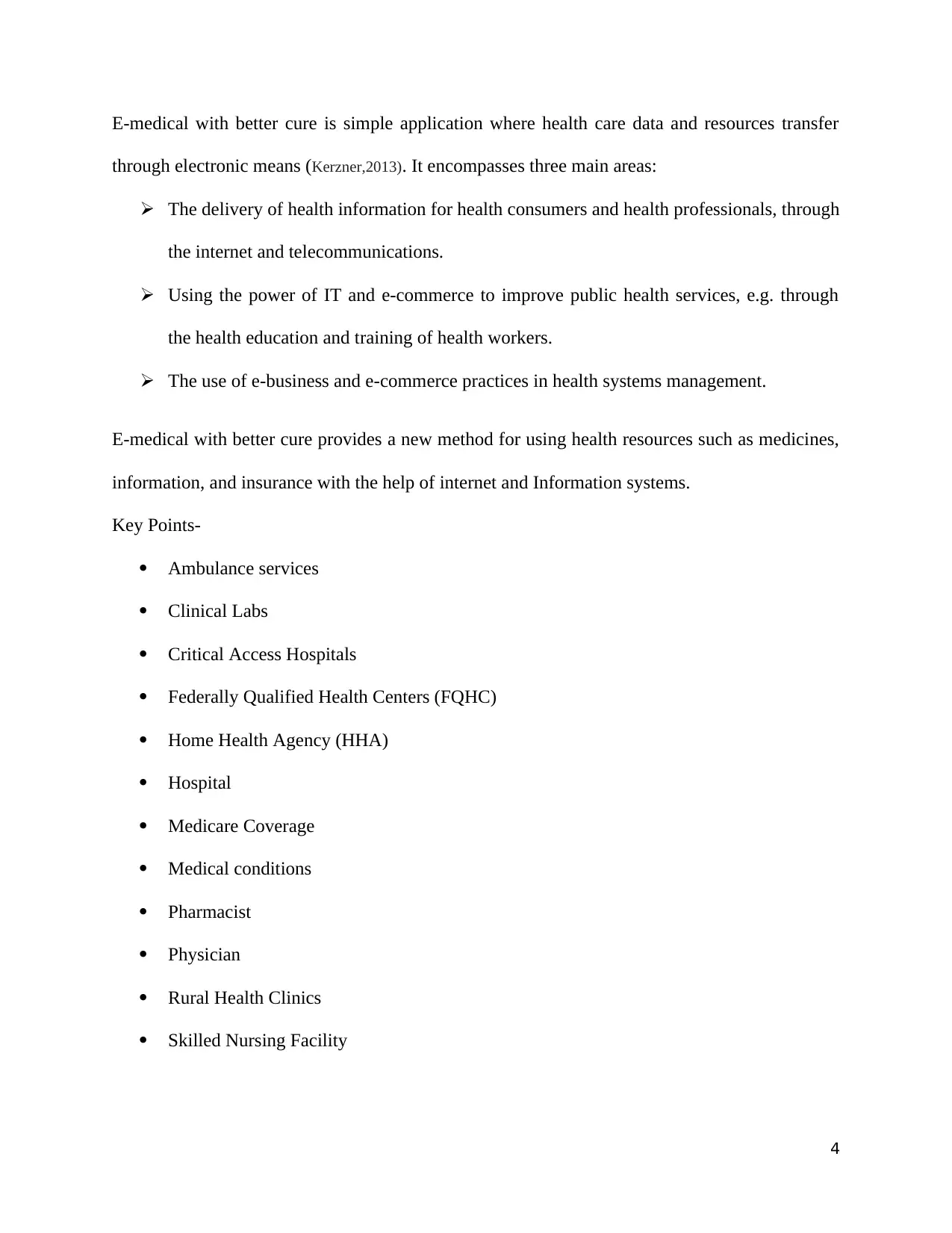
E-medical with better cure is simple application where health care data and resources transfer
through electronic means (Kerzner,2013). It encompasses three main areas:
The delivery of health information for health consumers and health professionals, through
the internet and telecommunications.
Using the power of IT and e-commerce to improve public health services, e.g. through
the health education and training of health workers.
The use of e-business and e-commerce practices in health systems management.
E-medical with better cure provides a new method for using health resources such as medicines,
information, and insurance with the help of internet and Information systems.
Key Points-
Ambulance services
Clinical Labs
Critical Access Hospitals
Federally Qualified Health Centers (FQHC)
Home Health Agency (HHA)
Hospital
Medicare Coverage
Medical conditions
Pharmacist
Physician
Rural Health Clinics
Skilled Nursing Facility
4
through electronic means (Kerzner,2013). It encompasses three main areas:
The delivery of health information for health consumers and health professionals, through
the internet and telecommunications.
Using the power of IT and e-commerce to improve public health services, e.g. through
the health education and training of health workers.
The use of e-business and e-commerce practices in health systems management.
E-medical with better cure provides a new method for using health resources such as medicines,
information, and insurance with the help of internet and Information systems.
Key Points-
Ambulance services
Clinical Labs
Critical Access Hospitals
Federally Qualified Health Centers (FQHC)
Home Health Agency (HHA)
Hospital
Medicare Coverage
Medical conditions
Pharmacist
Physician
Rural Health Clinics
Skilled Nursing Facility
4
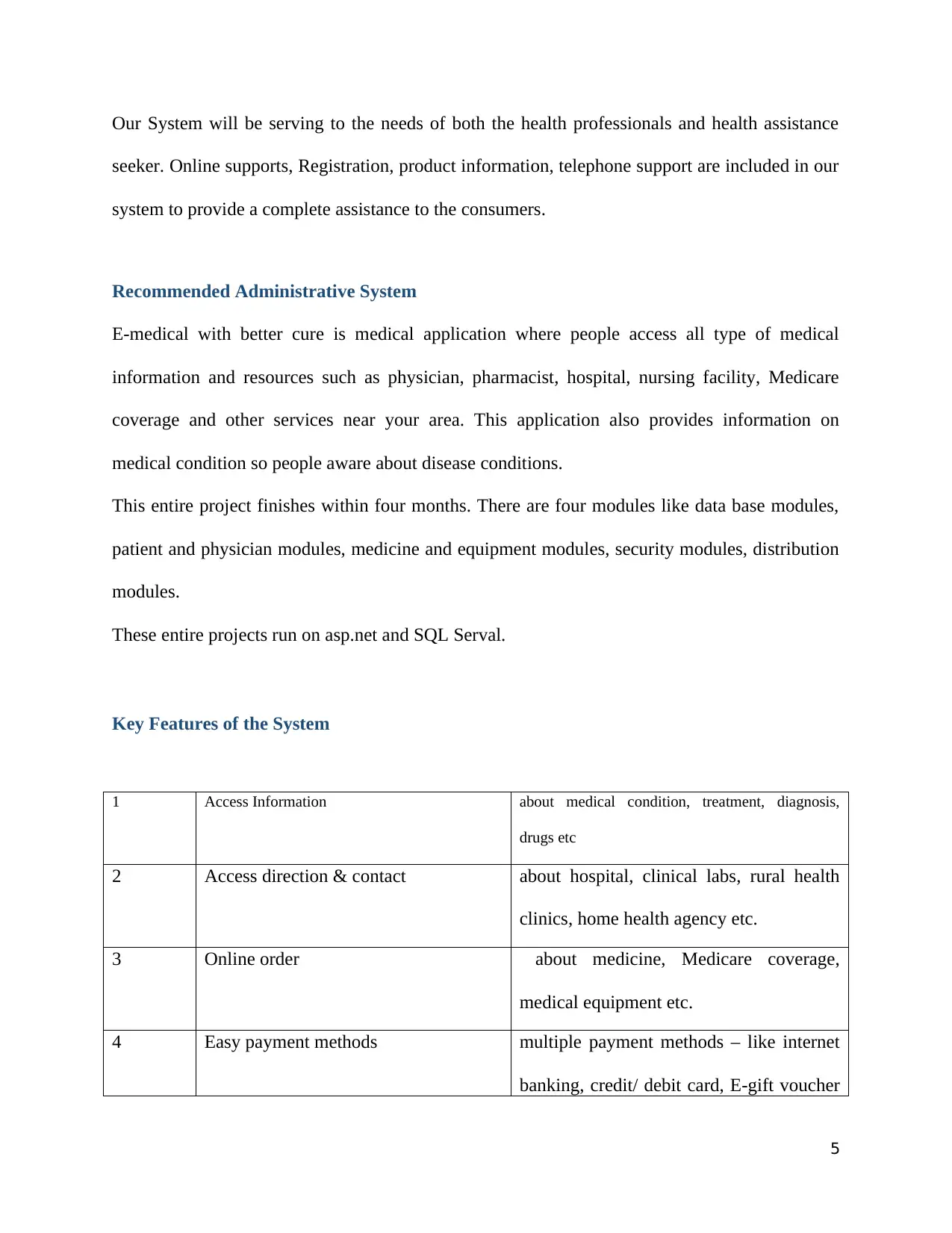
Our System will be serving to the needs of both the health professionals and health assistance
seeker. Online supports, Registration, product information, telephone support are included in our
system to provide a complete assistance to the consumers.
Recommended Administrative System
E-medical with better cure is medical application where people access all type of medical
information and resources such as physician, pharmacist, hospital, nursing facility, Medicare
coverage and other services near your area. This application also provides information on
medical condition so people aware about disease conditions.
This entire project finishes within four months. There are four modules like data base modules,
patient and physician modules, medicine and equipment modules, security modules, distribution
modules.
These entire projects run on asp.net and SQL Serval.
Key Features of the System
1 Access Information about medical condition, treatment, diagnosis,
drugs etc
2 Access direction & contact about hospital, clinical labs, rural health
clinics, home health agency etc.
3 Online order about medicine, Medicare coverage,
medical equipment etc.
4 Easy payment methods multiple payment methods – like internet
banking, credit/ debit card, E-gift voucher
5
seeker. Online supports, Registration, product information, telephone support are included in our
system to provide a complete assistance to the consumers.
Recommended Administrative System
E-medical with better cure is medical application where people access all type of medical
information and resources such as physician, pharmacist, hospital, nursing facility, Medicare
coverage and other services near your area. This application also provides information on
medical condition so people aware about disease conditions.
This entire project finishes within four months. There are four modules like data base modules,
patient and physician modules, medicine and equipment modules, security modules, distribution
modules.
These entire projects run on asp.net and SQL Serval.
Key Features of the System
1 Access Information about medical condition, treatment, diagnosis,
drugs etc
2 Access direction & contact about hospital, clinical labs, rural health
clinics, home health agency etc.
3 Online order about medicine, Medicare coverage,
medical equipment etc.
4 Easy payment methods multiple payment methods – like internet
banking, credit/ debit card, E-gift voucher
5
⊘ This is a preview!⊘
Do you want full access?
Subscribe today to unlock all pages.

Trusted by 1+ million students worldwide
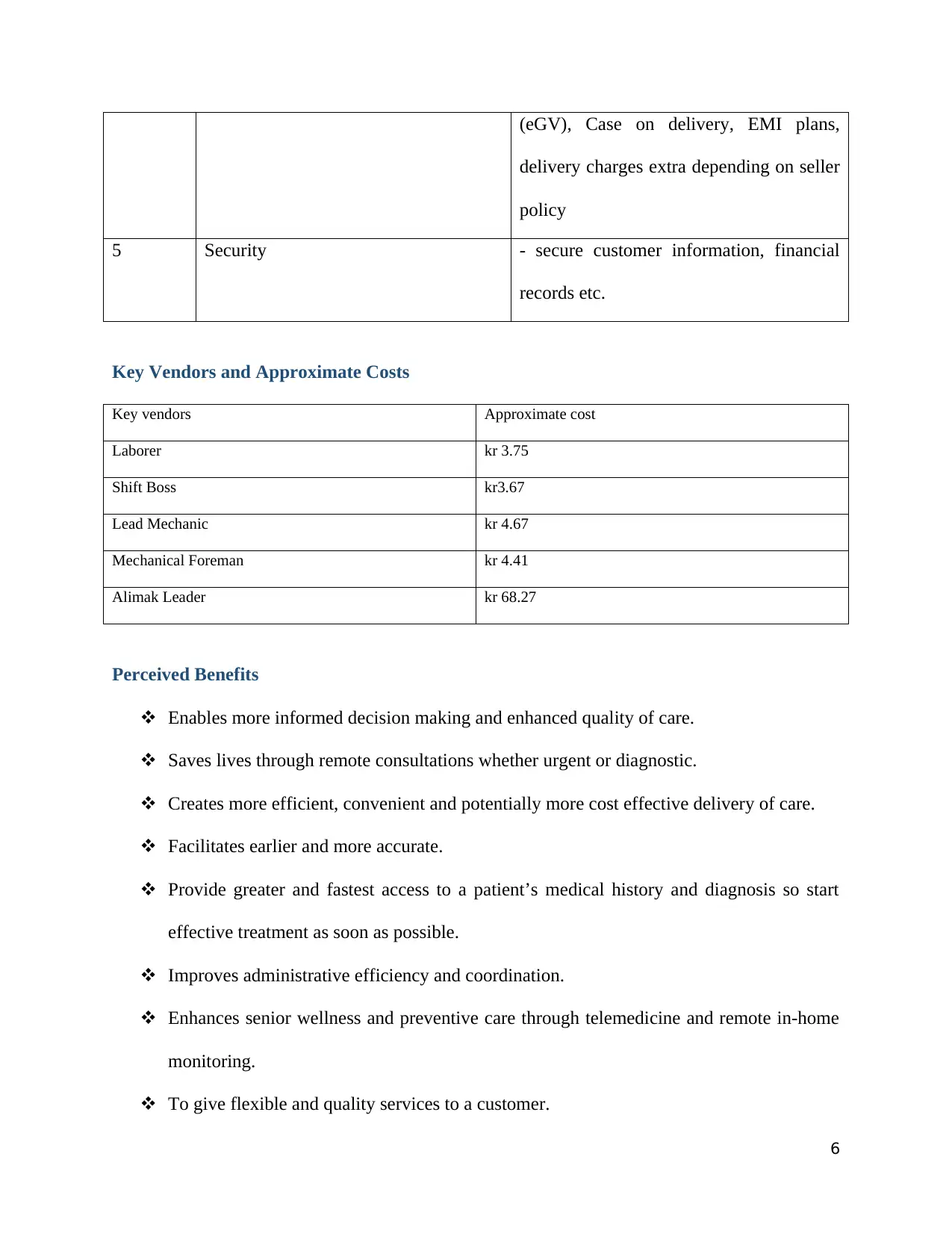
(eGV), Case on delivery, EMI plans,
delivery charges extra depending on seller
policy
5 Security - secure customer information, financial
records etc.
Key Vendors and Approximate Costs
Key vendors Approximate cost
Laborer kr 3.75
Shift Boss kr3.67
Lead Mechanic kr 4.67
Mechanical Foreman kr 4.41
Alimak Leader kr 68.27
Perceived Benefits
Enables more informed decision making and enhanced quality of care.
Saves lives through remote consultations whether urgent or diagnostic.
Creates more efficient, convenient and potentially more cost effective delivery of care.
Facilitates earlier and more accurate.
Provide greater and fastest access to a patient’s medical history and diagnosis so start
effective treatment as soon as possible.
Improves administrative efficiency and coordination.
Enhances senior wellness and preventive care through telemedicine and remote in-home
monitoring.
To give flexible and quality services to a customer.
6
delivery charges extra depending on seller
policy
5 Security - secure customer information, financial
records etc.
Key Vendors and Approximate Costs
Key vendors Approximate cost
Laborer kr 3.75
Shift Boss kr3.67
Lead Mechanic kr 4.67
Mechanical Foreman kr 4.41
Alimak Leader kr 68.27
Perceived Benefits
Enables more informed decision making and enhanced quality of care.
Saves lives through remote consultations whether urgent or diagnostic.
Creates more efficient, convenient and potentially more cost effective delivery of care.
Facilitates earlier and more accurate.
Provide greater and fastest access to a patient’s medical history and diagnosis so start
effective treatment as soon as possible.
Improves administrative efficiency and coordination.
Enhances senior wellness and preventive care through telemedicine and remote in-home
monitoring.
To give flexible and quality services to a customer.
6
Paraphrase This Document
Need a fresh take? Get an instant paraphrase of this document with our AI Paraphraser
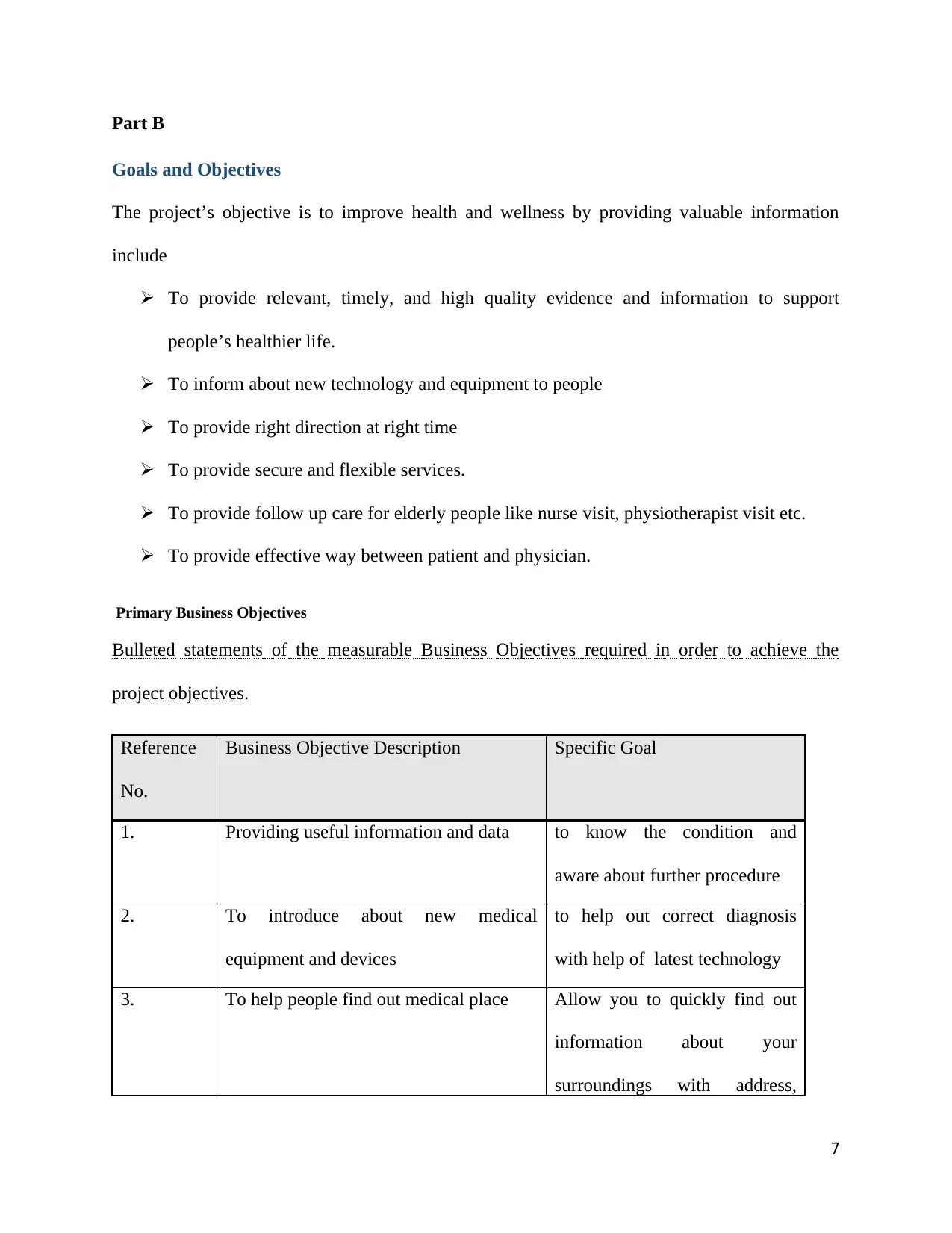
Part B
Goals and Objectives
The project’s objective is to improve health and wellness by providing valuable information
include
To provide relevant, timely, and high quality evidence and information to support
people’s healthier life.
To inform about new technology and equipment to people
To provide right direction at right time
To provide secure and flexible services.
To provide follow up care for elderly people like nurse visit, physiotherapist visit etc.
To provide effective way between patient and physician.
Primary Business Objectives
Bulleted statements of the measurable Business Objectives required in order to achieve the
project objectives.
Reference
No.
Business Objective Description Specific Goal
1. Providing useful information and data to know the condition and
aware about further procedure
2. To introduce about new medical
equipment and devices
to help out correct diagnosis
with help of latest technology
3. To help people find out medical place Allow you to quickly find out
information about your
surroundings with address,
7
Goals and Objectives
The project’s objective is to improve health and wellness by providing valuable information
include
To provide relevant, timely, and high quality evidence and information to support
people’s healthier life.
To inform about new technology and equipment to people
To provide right direction at right time
To provide secure and flexible services.
To provide follow up care for elderly people like nurse visit, physiotherapist visit etc.
To provide effective way between patient and physician.
Primary Business Objectives
Bulleted statements of the measurable Business Objectives required in order to achieve the
project objectives.
Reference
No.
Business Objective Description Specific Goal
1. Providing useful information and data to know the condition and
aware about further procedure
2. To introduce about new medical
equipment and devices
to help out correct diagnosis
with help of latest technology
3. To help people find out medical place Allow you to quickly find out
information about your
surroundings with address,
7
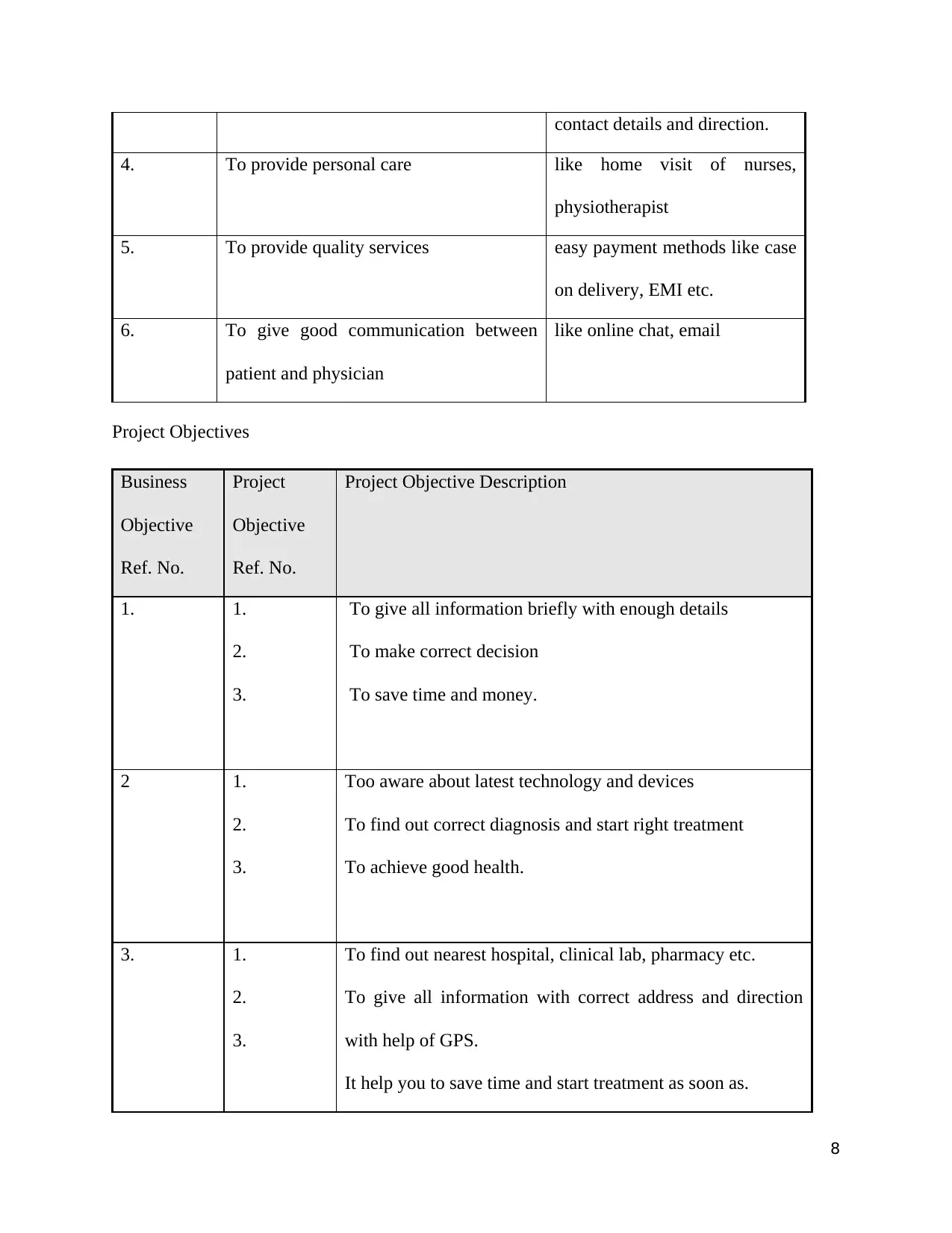
contact details and direction.
4. To provide personal care like home visit of nurses,
physiotherapist
5. To provide quality services easy payment methods like case
on delivery, EMI etc.
6. To give good communication between
patient and physician
like online chat, email
Project Objectives
Business
Objective
Ref. No.
Project
Objective
Ref. No.
Project Objective Description
1. 1.
2.
3.
To give all information briefly with enough details
To make correct decision
To save time and money.
2 1.
2.
3.
Too aware about latest technology and devices
To find out correct diagnosis and start right treatment
To achieve good health.
3. 1.
2.
3.
To find out nearest hospital, clinical lab, pharmacy etc.
To give all information with correct address and direction
with help of GPS.
It help you to save time and start treatment as soon as.
8
4. To provide personal care like home visit of nurses,
physiotherapist
5. To provide quality services easy payment methods like case
on delivery, EMI etc.
6. To give good communication between
patient and physician
like online chat, email
Project Objectives
Business
Objective
Ref. No.
Project
Objective
Ref. No.
Project Objective Description
1. 1.
2.
3.
To give all information briefly with enough details
To make correct decision
To save time and money.
2 1.
2.
3.
Too aware about latest technology and devices
To find out correct diagnosis and start right treatment
To achieve good health.
3. 1.
2.
3.
To find out nearest hospital, clinical lab, pharmacy etc.
To give all information with correct address and direction
with help of GPS.
It help you to save time and start treatment as soon as.
8
⊘ This is a preview!⊘
Do you want full access?
Subscribe today to unlock all pages.

Trusted by 1+ million students worldwide
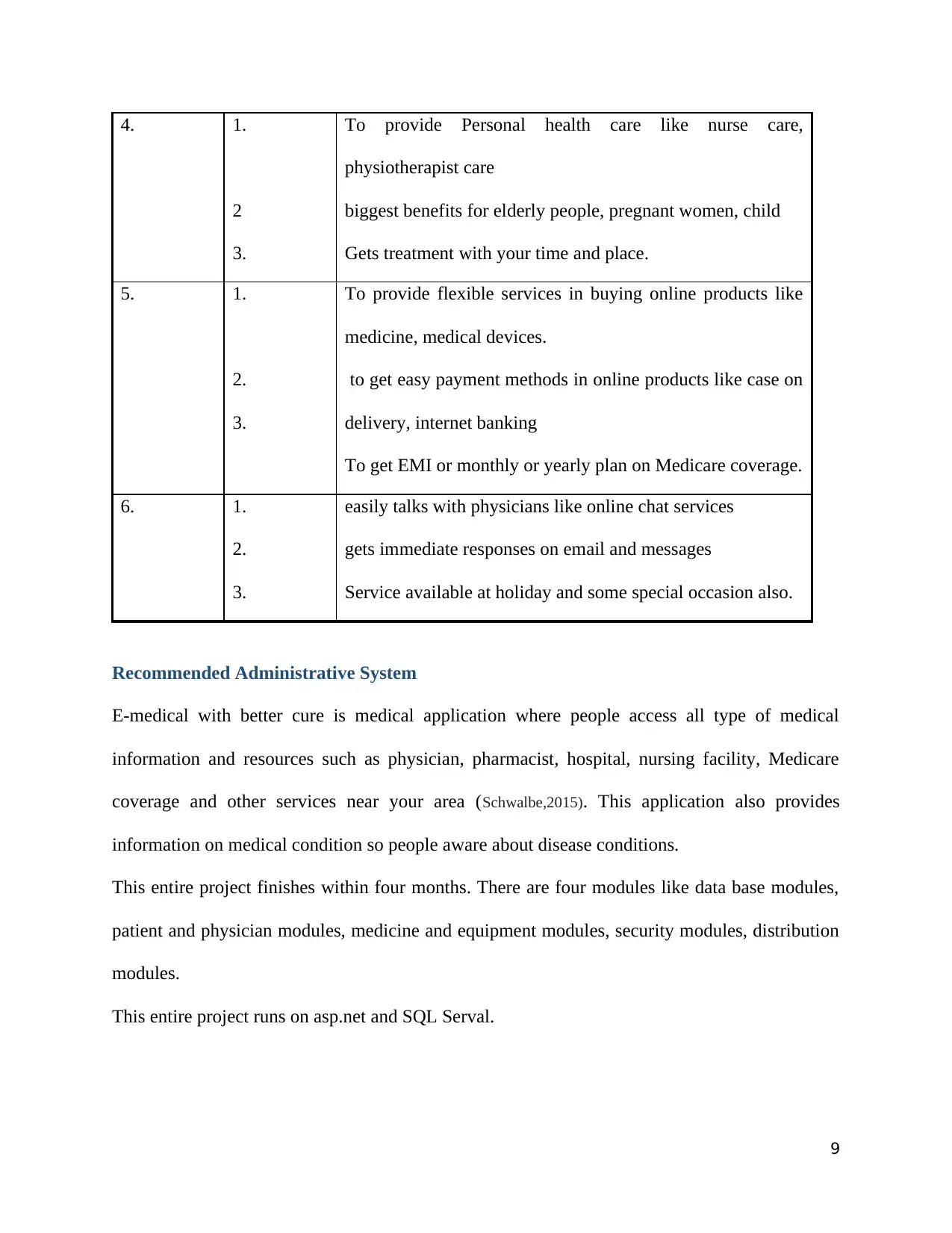
4. 1.
2
3.
To provide Personal health care like nurse care,
physiotherapist care
biggest benefits for elderly people, pregnant women, child
Gets treatment with your time and place.
5. 1.
2.
3.
To provide flexible services in buying online products like
medicine, medical devices.
to get easy payment methods in online products like case on
delivery, internet banking
To get EMI or monthly or yearly plan on Medicare coverage.
6. 1.
2.
3.
easily talks with physicians like online chat services
gets immediate responses on email and messages
Service available at holiday and some special occasion also.
Recommended Administrative System
E-medical with better cure is medical application where people access all type of medical
information and resources such as physician, pharmacist, hospital, nursing facility, Medicare
coverage and other services near your area (Schwalbe,2015). This application also provides
information on medical condition so people aware about disease conditions.
This entire project finishes within four months. There are four modules like data base modules,
patient and physician modules, medicine and equipment modules, security modules, distribution
modules.
This entire project runs on asp.net and SQL Serval.
9
2
3.
To provide Personal health care like nurse care,
physiotherapist care
biggest benefits for elderly people, pregnant women, child
Gets treatment with your time and place.
5. 1.
2.
3.
To provide flexible services in buying online products like
medicine, medical devices.
to get easy payment methods in online products like case on
delivery, internet banking
To get EMI or monthly or yearly plan on Medicare coverage.
6. 1.
2.
3.
easily talks with physicians like online chat services
gets immediate responses on email and messages
Service available at holiday and some special occasion also.
Recommended Administrative System
E-medical with better cure is medical application where people access all type of medical
information and resources such as physician, pharmacist, hospital, nursing facility, Medicare
coverage and other services near your area (Schwalbe,2015). This application also provides
information on medical condition so people aware about disease conditions.
This entire project finishes within four months. There are four modules like data base modules,
patient and physician modules, medicine and equipment modules, security modules, distribution
modules.
This entire project runs on asp.net and SQL Serval.
9
Paraphrase This Document
Need a fresh take? Get an instant paraphrase of this document with our AI Paraphraser
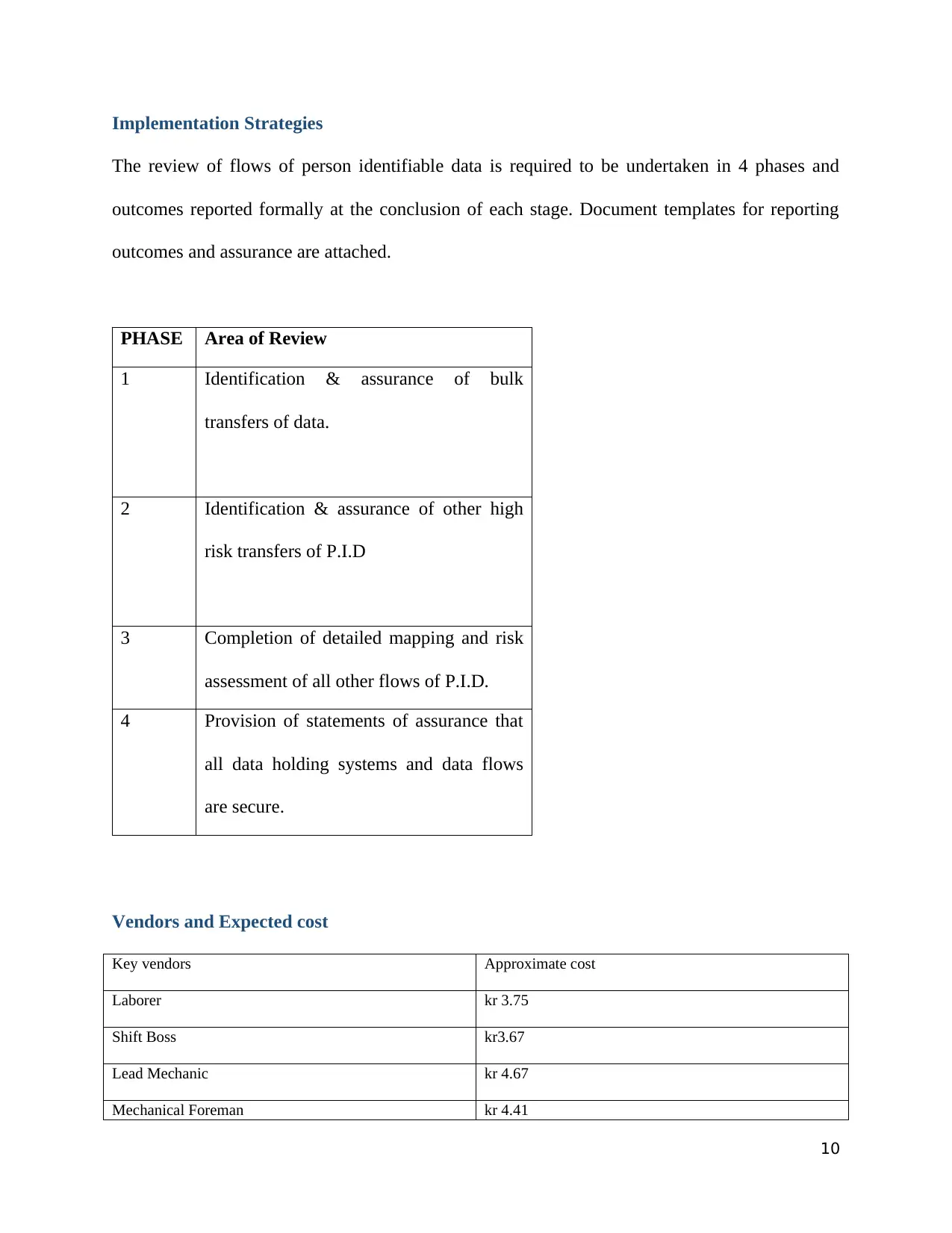
Implementation Strategies
The review of flows of person identifiable data is required to be undertaken in 4 phases and
outcomes reported formally at the conclusion of each stage. Document templates for reporting
outcomes and assurance are attached.
PHASE Area of Review
1 Identification & assurance of bulk
transfers of data.
2 Identification & assurance of other high
risk transfers of P.I.D
3 Completion of detailed mapping and risk
assessment of all other flows of P.I.D.
4 Provision of statements of assurance that
all data holding systems and data flows
are secure.
Vendors and Expected cost
Key vendors Approximate cost
Laborer kr 3.75
Shift Boss kr3.67
Lead Mechanic kr 4.67
Mechanical Foreman kr 4.41
10
The review of flows of person identifiable data is required to be undertaken in 4 phases and
outcomes reported formally at the conclusion of each stage. Document templates for reporting
outcomes and assurance are attached.
PHASE Area of Review
1 Identification & assurance of bulk
transfers of data.
2 Identification & assurance of other high
risk transfers of P.I.D
3 Completion of detailed mapping and risk
assessment of all other flows of P.I.D.
4 Provision of statements of assurance that
all data holding systems and data flows
are secure.
Vendors and Expected cost
Key vendors Approximate cost
Laborer kr 3.75
Shift Boss kr3.67
Lead Mechanic kr 4.67
Mechanical Foreman kr 4.41
10
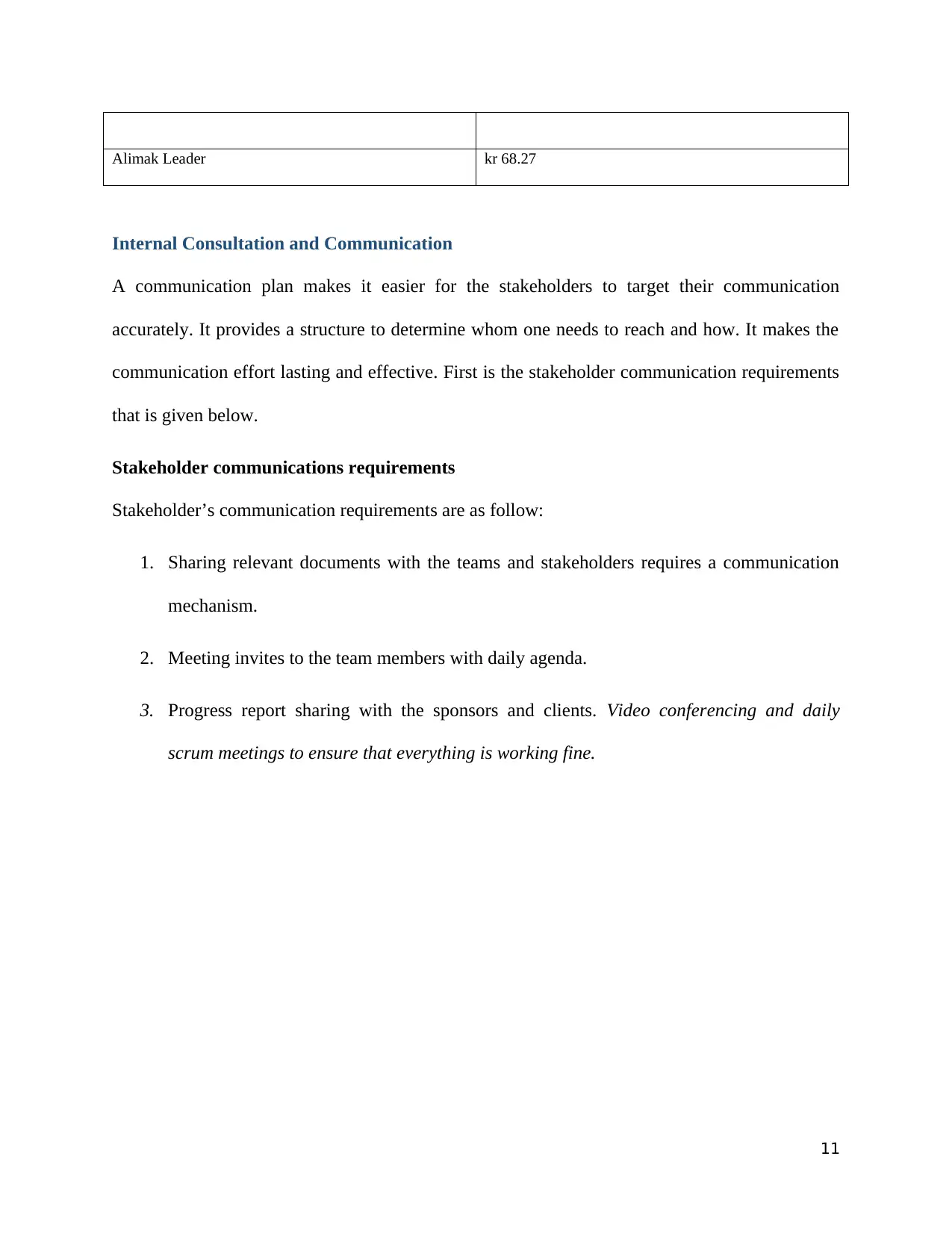
Alimak Leader kr 68.27
Internal Consultation and Communication
A communication plan makes it easier for the stakeholders to target their communication
accurately. It provides a structure to determine whom one needs to reach and how. It makes the
communication effort lasting and effective. First is the stakeholder communication requirements
that is given below.
Stakeholder communications requirements
Stakeholder’s communication requirements are as follow:
1. Sharing relevant documents with the teams and stakeholders requires a communication
mechanism.
2. Meeting invites to the team members with daily agenda.
3. Progress report sharing with the sponsors and clients. Video conferencing and daily
scrum meetings to ensure that everything is working fine.
11
Internal Consultation and Communication
A communication plan makes it easier for the stakeholders to target their communication
accurately. It provides a structure to determine whom one needs to reach and how. It makes the
communication effort lasting and effective. First is the stakeholder communication requirements
that is given below.
Stakeholder communications requirements
Stakeholder’s communication requirements are as follow:
1. Sharing relevant documents with the teams and stakeholders requires a communication
mechanism.
2. Meeting invites to the team members with daily agenda.
3. Progress report sharing with the sponsors and clients. Video conferencing and daily
scrum meetings to ensure that everything is working fine.
11
⊘ This is a preview!⊘
Do you want full access?
Subscribe today to unlock all pages.

Trusted by 1+ million students worldwide
1 out of 24
Related Documents
Your All-in-One AI-Powered Toolkit for Academic Success.
+13062052269
info@desklib.com
Available 24*7 on WhatsApp / Email
![[object Object]](/_next/static/media/star-bottom.7253800d.svg)
Unlock your academic potential
Copyright © 2020–2025 A2Z Services. All Rights Reserved. Developed and managed by ZUCOL.





